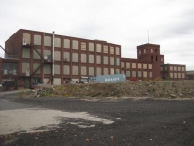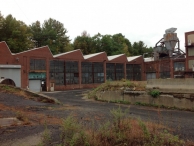Mill Record Torrington
RETURN TO ‘FIND MILLS’Disclaimer: Content for these properties was compiled in 2014-2017 from a variety of sources and is subject to change. Updates are occasionally made under Property Information, however the Connecticut Trust for Historic Preservation (dba Preservation Connecticut) makes no representation or warranty that the information is complete or up-to-date.
- Complex Name (Common)
- Hendey Machine Co. FIRE 9/2025
- Complex Name (Historic)
-
- Hendey Machine Co.
- Address or Location
- 105-123 Summer Street, Torrington
- County
- Litchfield
- Historic Designation
- Associated Mill Community
- n/a

- Historic Information
Companies Associated w/Complex
- Hendey Machine Co. 1870-1955
Use (Historic)
Largest Documented Workforce
Over 1,000 (c.1940)
Historic Narrative
The founder of the Hendey Machine Company, Henry John Hendey (1844-1906), was born in London, England. His family immigrated to Waterbury, Connecticut, in 1848, and in 1865, moved to Wolcottville (Torrington). In 1870, Henry and his brother Arthur, a New Haven pattern maker and machinist, established the Hendey Brothers, a machine tool company that built machinery on order. Their first shop was set up in a rented space of the Turner, Seymour, and Judd Co. machine shop on Lawton Street in Torrington. In 1871, they constructed a one story production shed on their father’s land, but outgrew it and built a two story wood frame factory on the present day site in 1873. At this time, the company employed up to twenty people, and early products included wood-working lathes, pin making machines for the local Excelsior Company, and clock, nail, and wire making machines. In 1874, the enterprise was incorporated as the Hendey Machine Company. While building machines on order was more costly than offering a standard line, Hendey’s success came from the practice of developing new machines. Many of Hendey’s custom order machines were modified lathes or shapers, containing commonly used parts and controls. Between 1870 and 1880, the Hendey Machine Co. workforce increased nearly 20% per year, and the factory grew at an impressive rate, with the replacement and expansion of buildings on a regular basis. In the 1870s, the first Hendey machines were sold in Europe, a trend that would continue throughout the company’s existence. After 1880, Hendey began to develop a standard line of shapers and lathes, and took fewer contracts for special order machines. In 1890, Hendey began production of a high-speed engine lathe, which became the mainstay of the product line. In 1892, an inventor named W.P. Norton patented a quick change screw-cutting gear box. Traditionally, if an operator wanted to change the cutting speed of a machine, he would need to manually change gears within the machine’s gear box. Norton’s invention allowed operators to change gear ratios without disassembly. Norton sold his patent to Hendey in 1892; he received a percentage on every machine Hendey sold utilizing the gear system, and became superintendent of the Hendey Company. The Norton gear box won a gold medal at the Chicago Exposition in 1892. In 1900, Hendey machines were exhibited at the Paris exposition. The Hendey Machine Co. enjoyed great success throughout World War I, supplying government contractors with much needed machinery. During the Great Depression, Hendey production was nearly halted, but the onset of World War II again increased growth and with it the labor force reaching at least 1,000 employees. The company was sold in 1952 to Frederick Richmond for two million dollars. Though Richmond stated that he intended to grow the company, he sold all Hendey assets two years later. Barber Colman, an Illinois machine tool company, bought the lathe and shaper product line. The property and buildings were sold c. 1955 to Anaconda American Brass which owned the Coe Brass Division across Summer Street.
- Architectural Information
Number of Existing Buildings
Nine (9) primary blocks.
Dates of Construction
c.1892, 1896, 1898, 1902, 1910, 1929
Architect
n/a
Builder
n/a
Building Type
Architectural Description
At its height, the complex consisted of eighteen separately constructed but interconnected buildings, c.1892 and c.1940. The Hendey Machine Co. occupied the complex until 1955. The first building on the site was constructed in 1873 but was long ago demolished for expansion. The oldest extant building is the office building on Summer Street (c.1892). Behind it, the U-shaped three-story brick loft with two water towers was built in stages in 1896, 1898 and 1902. The adjacent concrete buildings to the west (one with saw-tooth roof) were built in 1910. The two westernmost buildings on the corner of High and Summer Streets have saw-tooth roofs and were built in 1929. The centrally located foundry and power house burned down, however the pattern shop remains to the south. The easternmost buildings along the railroad were built by 1907.
Exterior Material(s)
Structural System(s)
Roof Form
Roof Material
Power Source
Condition
Good, Fair, Deteriorated
Condition Notes
n/a
- Property Information
-
Specific Location
Two parcels totaling 7.6 acres on the south side of Summer Street, between High Street to the west and the railroad to the east.
Adjacent To
Exterior Visible from Public Road?
Yes
Parcel ID / Assessor Record Link
Acreage
4.4; 3.2
Use (Present)
- Industrial
- Other: Eastern parcel had been under consideration as ConnDOT bus maintenance facility since c.2014; check status. Western parcel for sale in 2019.
- Vacant
- Sources
-
Form Completed By
Michael Farino
Date
October 2014
Bibliography
- Roth, Matthew, et al, Connecticut: An Inventory of Historic Engineering and Industrial Sites (Washington DC: SIA, 1981).
- Sanborn Insurance Atlases.
- McDerment, James F. 'Hendey History', Lathes.co.uk (n.d.). Web; accessed 2015.
- The Hendey Machine Company 1870-1920: A Brief Record of a Charted Course (Torrington: The Hendey Machine Co., 1922).
- Representative View(s)Click on image to view full file









